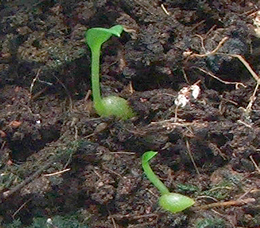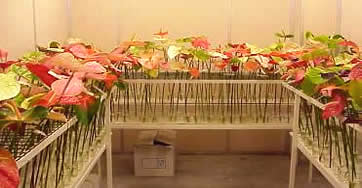|
Characteristics
|
The stems are short to elongate with a length between 15 and 30 cm. The simple leaves
come in many shapes. Most leaves are to be found at the end of the stem. They may
be erect or spreading in a rosette, with a length up to 40 cm. The leaves are petiolate.
In drier environments, the leaves can take a bird's-nest-shape rosette that enables
the plant to collect water. Terrestrials or epiphytes usually have cordate leaves.
Some grow as vines with rosettes of lanceolate leaves. Some species have many-lobed
leaves.
|

|

|
The flowers are small (about 3 mm) and develop crowded in a spike with a fleshy
axis and called a spadix, a characteristic of the arums. This spadix can take on
many forms (club-shaped, tapered, spiraled, and globe-shaped) and colors (white,
green, purple, red, pink, or a combination).
|
Usually just below the flower spike lies a colorful, solitary spathe: a showy modified
bract that can be somewhat leathery in texture. The spathe can vary in color from
pale green to white, rose, orange or shiny red (such as A. andrenaum).
The color changes between the bud stage and the anthesis, (the time the flower expands).
Thus the color might change from pale green to reddish purple to reddish brown.
The flowers are hermaphrodite, containing male and female flowers. The fruits are
usually berries with one to multiple seeds on a pendent infructescence.
The flowers of Anthurium give off a variety of fragrances, each attracting
a variety of specific pollinators.
|

|
Top
Climate
Anthurium is one of the important economic flowers of export potential. There are
more than 500 species and several varieties. Few of them are commercially important.
Anthurium andreanum, A. veitchii and A. scherzerianum
are the economically viable species. Many of them are partially epiphytic in growth
habit. Plants prefer to grow under shade. The tolerable level of light in the tropical
region during summer is 20-30 per cent. Excess light causes yellowing and scorching
of leaves. Very low light intensity causes excessive vegetative growth and low flowering.
It is preferable to grow anthurium in the open, under artificial shade structures
for better growth and yield. Plant prefers to grow under a relative humidity of
not less than 60 per cent and a temperature of not more than 18-28ºC.
Top
Varieties
The economic varieties suitable for Kerala condition are Lima White, Cuba, Agnihotri,
Liver Red, Can Can, Tropical, Nitta, Sunburst, Linda-de-Mol, Tinora, Acropolis,
Gino Orange and Midori.

|

|

|

|

|
|
Lima White
|
Tropical
|
Nitta
|
Acropolis
|
Midori
|
Top
Propagation
Anthurium is multiplied by seed and vegetatively by stem cuttings or by separation
of basal sprouts. Propagation by seed is not recommended as a commercial propagation
method as it results in high variability. Plants can be multiplied in large number
by micro-propagation techniques from the tender leaf bits.
Seed propagation

Seeds are produced by hand pollination. Selfing or crossing can be made. Seeds become
mature within a period of 4-6 months after pollination. Mature seeds will have a
pulpy coating. The pulp is carefully removed without injuring the soft seed. Seeds
are sown immediately after extraction. Sowing is done on a medium of clean fine
sand or on a moist cotton pad. Sprouted seeds on cotton pad are shifted to a sand
medium for further growth. Seedlings will take two years for flowering.
Vegetative propagation
Plants are propagated vegetatively by cutting the thick main stem into 3-4 cm long
discs. If the stem is very thick, the discs can be cut vertically. Each bit should
have minimum two lateral buds. Cut-pieces are treated with a fungicide solution
and planted on a medium of clean river sand. Cuttings will take 1-2 months for sprouting.
Suckers from flowering plants can also be separated as and when available and planted
in the medium.
Seedlings and sprouted cuttings of 5-10 cm height are transferred to the main field
or pots. Planting in pots is preferred in the plains. Cultivation in beds is good
at higher altitudes (about 1000 m above MSL). A loose medium above the ground is
suitable for anthurium. Old and chopped coconut husk (3 cm size) mixed with brick
pieces and charcoal are filled in narrow trenches 10 cm below and above ground level.
Pots can also be filled with the same mixture. An ideal pot should be 30 cm diameter
at top with 3 large holes at the bottom on sides. One seedling can be planted in
a pot. On ground, the spacing is 45 to 60 cm depending up on the variety. Fresh
cowdung or neem cake mixed with 10-15 times of water, kept for 4-5 days, can be
sprayed on the plants after filtering. Cow's urine can be sprayed or drenched after
mixing with 25 times of water. Complex fertilizer (N:P2O5:
K2O 19:19:19) 2 g/l of water is applied in the medium once a week. Slow
release fertilizers, if used, need be given only once in 2-3 months.
Pruning of older leaves, removal of suckers at young stage, cleaning of crown before
rains etc. are other operations to be carried out in order to have a better growth
and flowering.
Top
Plant
Protection
Diseases
The two major diseases are bacterial blight and anthracnose.
Anthracnose

|
Anthracnose is caused by the fungus Colletotrichum gloeosporioides.
Symptoms start as tiny brownish spots on the flower spadix. During high humidity
these spots enlarge, appear water-soaked and turn necrotic. Sometimes the entire
spadix will turn black as lesions coalesce. The shape of most lesions is, however,
angular due to the shape of the spadix tissue. As the disease becomes more severe,
masses of orange coloured spores form on necrotic areas. Leaves and spathes are
rarely if ever infected.
|
Bacterial blight disease
|
Bacterial blight disease is caused by Xanthomonas campestris pv. dieffenbachiae.
In the humid tropics, high rainfall coupled with year-round high temperatures increases
the severity and spread of bacterial blight disease making it a very important impediment
to the cultivation of anthurium. Blackening of the stem and decay of leaf axils
are the symptoms of bacterial blight.
|

|
Control
Spraying mancozeb 0.3% or carbendazim 0.05% can control the disease. Root rot caused
by Pythium and Phytophthora can be controlled by the application
of potassium phosphonate 0.3%.
The most effective control measure for bacterial blight disease is the use of resistant
cultivars. The use of such cultivars will reduce the cost and risk associated with
anthurium cultivation.
Pests
The major pests are scales and bugs, which are controlled by spraying malathion
@ 2 ml per litre of water.
Snails also cause damage to young roots. Slugs and snails are of quarantine significance
on exported plant material. Control must be 100% for quarantine security. Sanitation
is vital to slug control. Slugs escape hot, dry conditions by hiding between the
soil surface and any material on the soil during the daytime. Removing boards, pots,
and any debris from growing areas will reduce slug cover for slug and snail breeding
areas. Pruning anthurium plants will allow sunlight to reach the soil. Weather conditions
affect slug and snail populations. Hot dry weather or excessive flooding can reduce
the populations; while cool, damp weather encourages population growth. Baits are
the preferred method of control. Baits consist of a base that is attractive to slugs
plus a poison. Use of metaldehyde can prevent the attack of snails.
Top
Harvesting
The flowers are harvested with its long stem when 1/4th to 3/4th flowers on the
spadix are open, indicated by the change of colour. Colour change varies with the
varieties.
Post-harvest operations
(Source: http://www.ctahr.hawaii.edu/fb/anthuriu/anthuriu.htm#top)
Although the industry has no major packaging problem, it is very much concerned
with the shelf-life and the quality of flowers upon arrival at the markets.
Floral injury
Factors such as the mode of transportation, conditions during transport and while
in storage at the distributors, time lag from shipment to ultimate sale ("Chain-of-Life")
are very important in the maintenance of quality and extending shelf-life. The industry
believes that most of the abuse suffered by the flowers occur after the flowers
leave the packing shed and before they arrive in the markets. Flowers sometimes
freeze in transit during the winter. During the summer, flowers are damaged while
they are stored in containers left in the open at airports where the temperature
within the containers could reach 49oC or higher.
The quality of the water in which flowers are held after harvest also affects the
quality of the flowers.
Post-harvest life
The industry would like to see if proper nutrition and other cultural practices
could pre-condition flowers to withstand post-harvest handling and transportation
abuses better. Reduced post-harvest life is apparently associated with clogging
of the vascular tissue in the stem by a flower-produced material. Silver nitrate
(together with distilled water) treatment of the stem reduces this blockage and
helps maintain water conducting tissue, thereby increasing post-harvest life by
up to 50%. Initial results indicate that surface shipping of anthuriums and accumulation
of flowers for peak demand with air shipment is feasible using dry packing procedures
and silver nitrate treatment.
Reduced water loss from the flower by wax coating also increases post-harvest life
up to 30%. The best wax of those tested was a carnauba base wax (FMC-819). Both
of these treatments (silver nitrate and wax) have commercial possibilities with
the wax treatment being the easiest to use. Some growers who have used the wax treatment
say that the added sheen is very attractive.
Vaselife

In tests conducted on the farm, it was found that calcium nitrate treatment in combination
with waxing at 80% relative humidity (RH) significantly increased shelf-life of
miniature anthuriums.
In experiments on refrigerated storage, it was found that there is no significant
difference in the vase-life of flowers when stored at 13oC and at room
temperature for 7 days.
The major limitation to post-harvest life is apparently the clogging of the water-conducting
tissue of the stem. Until this problem is completely overcome, other treatments
may not significantly improve total post-harvest life.
Top
|